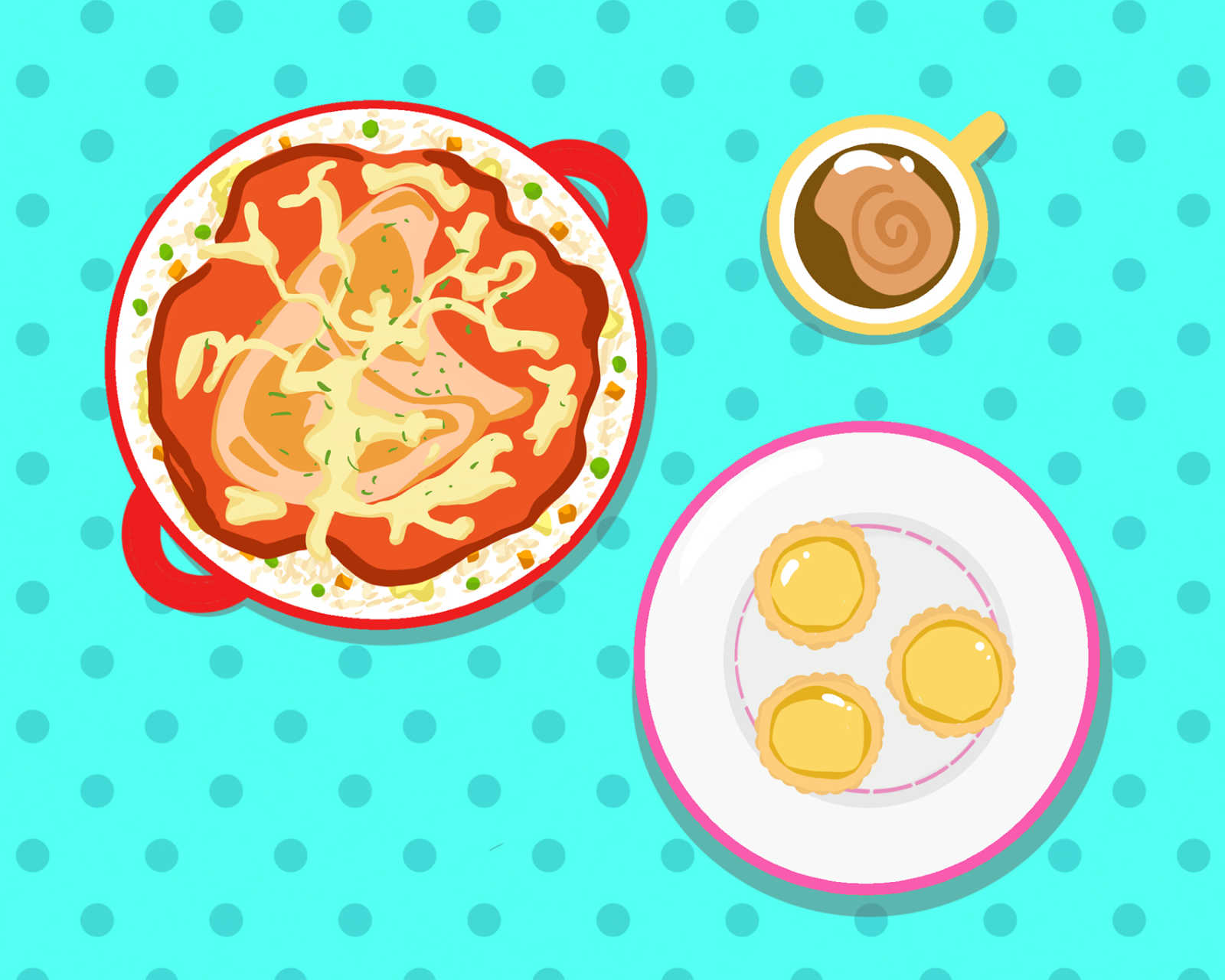It's 1955, and it's a hot day in Hong Kong. You're a hustling salaryman, and you only have 20 minutes before your next meeting. You want something cheap, filling, and caffeinated to get you through the rest of the day. Where do you go?
Your local cha chaan teng–at least according to my grandpa, who was born and raised in HK and still thinks back on those golden days fondly. Though the term 茶餐厅 / cha chaan teng literally translates to "tea restaurant", I prefer the translation Hong Kong cafe, which better captures the raucous charm of these quick-service establishments. A Chinese take on British afternoon tea, their menus are shamelessly fusion in nature, featuring such delights as 鴛鴦 (yuenyueng) – two parts tea, one part coffee, and milk – "Western toast," a deep-fried peanut butter sandwich slathered with butter and condensed milk, and my personal favorite, 焗豬排飯 (gok ju pa fan) AKA baked pork chop rice.

If you're a regular at a cha chaan teng, you'll likely know what you want to eat even before you sit down. This is good, because in classic Cantonese style, the waiters generally have little patience for wavering diners. Instead, you'll fire off your order with the usual adjustments – perhaps you'll ask for 茶走 (cha jau) to get your tea with condensed rather than evaporated milk, or 炒底 (chaau dai) to get your dish with fried instead of steamed rice – and in minutes, there it will be in front of you. Cheap, steaming hot, and ready to give you the energy for another day of hard work as a Hong Kong salaryman.
Though cha chaan teng haven't gained mainstream recognition in the West as dim sum has, I think it might just be a matter of marketing. Though I can easily see a proper Brit turning their nose up at the "set meals" (think toast and eggs, macaroni soup with ham, and a drink) that is the cha chaan teng take on English breakfast, it's hard to imagine that most Americans wouldn't love tucking into this type of soul food. They’re still abundant in the port city today, but with the future of Hong Kong on the brink, these little cafes are yet another aspect of HK culture that is worth saving.
The Recipes
Baked Pork Chop Rice • 焗豬扒飯
Hong Kong Milk Tea • 港式奶茶
The highlight of today's menu, baked pork chop rice, is actually several dishes in one. First, you have a layer of eggy, ketchuppy fried rice. Above that, you have a rich layer of tomato sauce and melty mozzarella cheese. Finally, you have the pork chops, which have a delightful kick of white pepper. Call it fusion, call it soul food, call it whatever you'd like, but it's definitely the kind of dish that puts you into a comfortable stupor.
But of course, you can't have a "tea restaurant" without the tea, which is why the first item on today's menu is a classic Hong Kong-style 奶茶 (naai cha), or milk tea. Its claims to fame are its punchy tea flavor and smooth yet creamy texture, which comes from evaporated or condensed milk. It's the perfect caffeine boost to balance out all that pork chop rice, or an indulgent treat for any time of the day.
Plan of Attack
As usual, here’s my suggested game plan for assembling this week’s meal.
Equipment: Baking dish, dutch oven, or cast iron pan
Set the table: You’ll need a fork, knife, spoon, plate, and mug for each diner.
Prep the milk tea and set it aside.
Mise-en-place: Prep all the ingredients for the pork chop rice.
Make the pork chop rice. At the last step, while the pork chop is broiling, heat up the milk tea and pour into mugs, or pour into glasses over ice.
Serve (and try not to fall too hard into a food coma!)
Food for Thought
The Fragrant Harbor
The Chinese characters in the name Hong Kong / 香港 literally translate to “Fragrant Harbor.” For anyone familiar with the bustling city, the name might sound strange at first–Hong Kong has many aromas, but “fragrant” isn't a word I would use to describe many of them.
There are a few theories for how the city got its name, but my favorite centers around the aquilaria tree. Aquilaria don’t look particularly remarkable at first glance, but what makes them special is their wood. When infected with a mold called Phialophora parasitica, the trees produces a dark, fragrant resin known as agarwood. Agarwood is one of the most expensive natural raw materials in the world, fetching prices of up to $100,000/kg for top-grade resin.

It’s said that back in the 19th century, the local villagers who inhabited Hong Kong planted many of these trees for their good feng shui. Eventually, the resin came to be used for Buddhist and Taoist sculpture, as an ingredient in Chinese medicine, and most importantly, for incense. The resin’s fragrance is said to bring peace of mind and good luck, and even now is prized as an ingredient in luxury perfumes. The export of this incense from Hong Kong’s Aberdeen harbor may be what led to the term “fragrant harbor.” Though poachers have made the trees a rare sight nowadays, this piece of the city’s history endures in the city’s name.
That’s all for now! I hope you enjoyed learning about the history of this iconic city. Every time I've visited, I've been simply blown away by the sheer deliciousness present on every street corner. Needless to say, Hong Kong is in for some major change in the years to come. While I regret not having had the chance to spend more time in the Hong Kong of today, my fingers are crossed for a brighter future ahead–and, perhaps with it, a new wave of culinary innovation.

